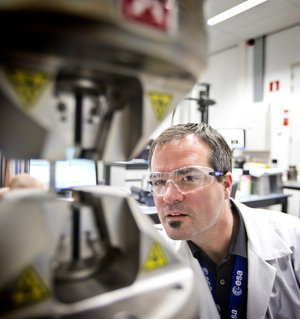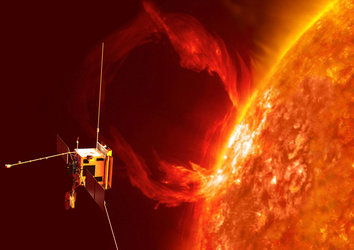Materials make the space mission
Tommaso Ghidini, Head of ESA’s Materials Technology section
Materials make the space mission: manufacturing materials and processes must be chosen with great care.
Space is a not a single environment, but many: simply getting into orbit stresses materials to their limits. A rocket launch combines high temperatures and pressure with additional stresses due to shock, vibration, aerodynamic and acoustic forces. The earliest satellites launched by Europe simply went into Earth orbit, but then came interplanetary missions like Ulysses, Huygens and Rosetta which had to contend with the cold darkness of deep space.
Meanwhile probes to the inner Solar System were faced with the opposite problem of escalating solar flux and temperatures, starting with Venus Express, then the BepiColombo mission to Mercury (to be launched in April 2018) – which could at least shelter behind the innermost planet during part of its orbit.


Access the video
But ESA’s Solar Orbiter, also launching in 2018, will have nowhere to hide, tasked with high-resolution imaging of the Sun from as near as 42 million km away – a little more than a quarter Earth’s distance from its parent star. In the process it will be operating in the continuous direct view of the Sun, enduring 13 times the intensity of terrestrial sunlight, resulting in surface satellite temperatures of 500°C or more.
As the head of ESA’s Materials Technology section – focused mainly on metallic materials and their related preparation and manufacturing processes – Solar Orbiter is a good example of the kind of challenges that come our team’s way.
The spacecraft’s main body takes cover behind a multi-layer 3.1m by 2.4 heat shield. This heat shield works to absorb sunlight, then convert it to infrared to radiate it back to space. To achieve this its surface has to maintain constant ‘thermo-optical properties’ – to keep the same colour despite years of exposure to extreme ultraviolet radiation.
At the same time, the shield surface cannot crack, shed material or release vapour, because this might contaminate Solar Orbiter’s highly-sensitive instruments. Any build-up of static from the close-up solar wind was also unacceptable. Tests in our STAR ‘Synergistic Temperature Accelerated Radiation’ Chamber showed that our current suite of materials and coatings were unable to meet the performance we needed.
It was time to look for a solution outside the space industry
It was time to look for a solution outside the space industry. As materials processes experts, we are constantly scanning the European industrial landscape, looking for emerging technologies with potential for space.
In this instance we found it with an Irish company called ENBIO and a technique called ‘Co-Blast’, developed to coat titanium-made medical implants. It works with reactive metals like titanium, aluminium and stainless steel, which possess a natural surface oxide layer. This surface is stripped away and switched for with a ‘dopant’ material, ending up bonded to the metal, rather than painted or stuck on – effectively becoming part of it. The material to be added to the outermost titanium layer of Solar Orbiter’s heat shield is called ‘Solar Black’ – a type of black calcium phosphate processed from burnt-bone charcoal, commonly used by industry – and found also in prehistoric cave paintings.
The treated titanium underwent a gamut of testing to ensure it met baseline requirements, everything from accelerated sunlight and UV exposure to ‘tape pull’ – simply applying then pulling off adhesive tape.
That was only the start however; we needed to bring up the material and its production process to a certain level of maturity, which involved installing a laboratory at ENBIO’s facilities and working closely with them to meet the specific mission needs. So – within a relatively rapid two years –Solar Black ended up baselined for the heat shield and another ENBIO product called ‘Solar White’ ended up treating other parts of Solar Orbiter, including its antenna and instrument booms and solar array attachments.
If you qualify for space, it’s really a sign you’re able to do everything else too. So ENBIO, having achieved ESA acceptance, has gone on to find other lucrative space and hi-tech markets, set to supply coatings to commercial telecom satellites as well as a large North American cars manufacturer. And thanks to meeting the needs of this ambitious space science mission, and our continuous monitoring and mapping of the European industry, we’ve been able to help bring the company up to the next level of the market.














 Germany
Germany
 Austria
Austria
 Belgium
Belgium
 Denmark
Denmark
 Spain
Spain
 Estonia
Estonia
 Finland
Finland
 France
France
 Greece
Greece
 Hungary
Hungary
 Ireland
Ireland
 Italy
Italy
 Luxembourg
Luxembourg
 Norway
Norway
 The Netherlands
The Netherlands
 Poland
Poland
 Portugal
Portugal
 Czechia
Czechia
 Romania
Romania
 United Kingdom
United Kingdom
 Slovenia
Slovenia
 Sweden
Sweden
 Switzerland
Switzerland





























